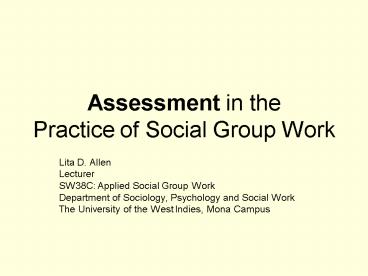Assessment in the Practice of Social Group Work - PowerPoint PPT Presentation
1 / 20
Title:
Assessment in the Practice of Social Group Work
Description:
Assessment in the. Practice of Social Group Work. Lita D. Allen. Lecturer ... Department of Sociology, Psychology and Social Work ... – PowerPoint PPT presentation
Number of Views:539
Avg rating:3.0/5.0
Title: Assessment in the Practice of Social Group Work
1
Assessment in the Practice of Social Group Work
- Lita D. Allen
- Lecturer
- SW38C Applied Social Group Work
- Department of Sociology, Psychology and Social
Work - The University of the West Indies, Mona Campus
2
- Reference
- Toseland, R. W. Rivas, R. F. (2005). An
introduction to group work practice (5th. Ed.).
Boston, MA Allyn Bacon. - Chapter 8, pp. 219 - 253
3
General Definition
- Assessment is a holistic (biological,
psychological, social, cultural, spiritual,
environmental) approach to understanding
particular practice situations in order to plan
effective interventions.
4
General Definition
- Assessment is both a process and a product
upon which the helping process is based.
(Siporin, 1975)
5
Group Assessment
- As a process, assessment involves gathering,
organizing and making judgments about
information. - As a product, assessment is a verbal or written
statement of the functioning of the group and its
members, which is useful in the development of
intervention plans. -
p. 219
6
Group Assessment
- Assessments are made at all stages of the group
- The process, however, is most dominant at the
beginning stage - The purpose is to ensure an early understanding
of how individuals and the group as a whole are
functioning
7
Issues in the Assessment Process
- What kind of information?
- How much information?
- What are the real issues raised by each member
and by the group as a whole? - What should be the assessment focus?
- How can I avoid diagnostic labelling?
- p. 221 - 224
8
Areas of Assessment
- The functioning of
- Individual group member
- The group as a whole
- The group environment
- The leader / leadership of the group
- with special attention to
- the interactional forces (the total dynamics)
and the - here-and-now of group interaction (the group
process)
9
Determine your theoretical orientation
- For example
- Psychodynamic
- Systems
- Field / Group Dynamics
- Learning
- Social Exchange
- Transactional Analysis etc.
- N.B. Note similarities and differences. What
would be the value of an integrative approach?
10
Assessing the Functioning of Individual Group
Members
- What to Assess
- Current functioning in the group
- Members functioning from a developmental
perspective - How the personal characteristics of each member
(race, culture, gender, age) interact with
functional abilities
11
Assessing the Functioning of Individual Group
Members
- Areas of Assessment
- Intrapersonal (self)
- Interpersonal (others)
- Extrapersonal (environment)
12
Assessing the Functioning of Individual Group
Members
- How to Assess
- Self-observation
- Worker observation
- Report by others
- Standardized instruments
- pp.
224-232
13
Assessing the Functioning of the Group as a Whole
- Areas of Assessment (Utilize the 4 major areas of
group dynamics) - Communication and interaction patterns
- Cohesion
- Control mechanisms at the social level also
referred to as Social integration and influence
dynamics norms, roles (p. 234) status
hierarchies - Culture of the group
- Chapter 3,
pp. 64-91
14
Assessing the Functioning of the Group as a Whole
- How to Assess (Structured methods vs Subjective
Observations) - Measuring communication and interaction (Semantic
differential scale) - Measuring interpersonal attraction and cohesion
- (Sociometry)
- Measuring social controls and group culture
- (Bales SYMLOG)
- NB Students are not required to learn these
methods. - pp. 232-244
15
Assessing the Groups Environment
- Focus of Assessment
- Environmental factors that affect individual
group members - Environmental influences on the functioning of
the entire group
16
Assessing the Groups Environment
- What and How to Assess
- The organization that sponsors and sanctions the
group. Assess in relation to - - Purpose of organization
- - Policies regarding recruitment and intake of
potential members - - Status of worker in organization
- - Allocation of resources
- - Commitment to a particular service technology
17
Assessing the Groups Environment
- What and How to Assess
- The Interorganizational Environment
- - Are other organizations doing similar work?
- - How similar or different are other
organizations perceptions of group needs,
issues, and solutions? - - What are the benefits to be gained by linking
with groups in other organizations? - Why is it important to let other organizations
know what you are doing?
18
Assessing the Groups Environment
- What and How to Assess
- The Community Environment
- - What is the extent of support for the group
from other community groups? - - What is the attitude of the community to the
problems or issues being raised by the group? - - What might be the level of stigmatization?
- pp. 244-249
19
Assessing the Leader / Leadership of the Group
- Use of power bases
- Style of leadership
- Role and functions
- Demonstration of specific leadership skills
- Co-leadership skills
- What interventions were made to deal with issues
raised and how effective were these interventions?
20
- The purpose of doing a comprehensive group
assessment is to ensure that effective
interventions are selected as part of a
comprehensive treatment or action plan. - See Figure 8.6
on p. 250































